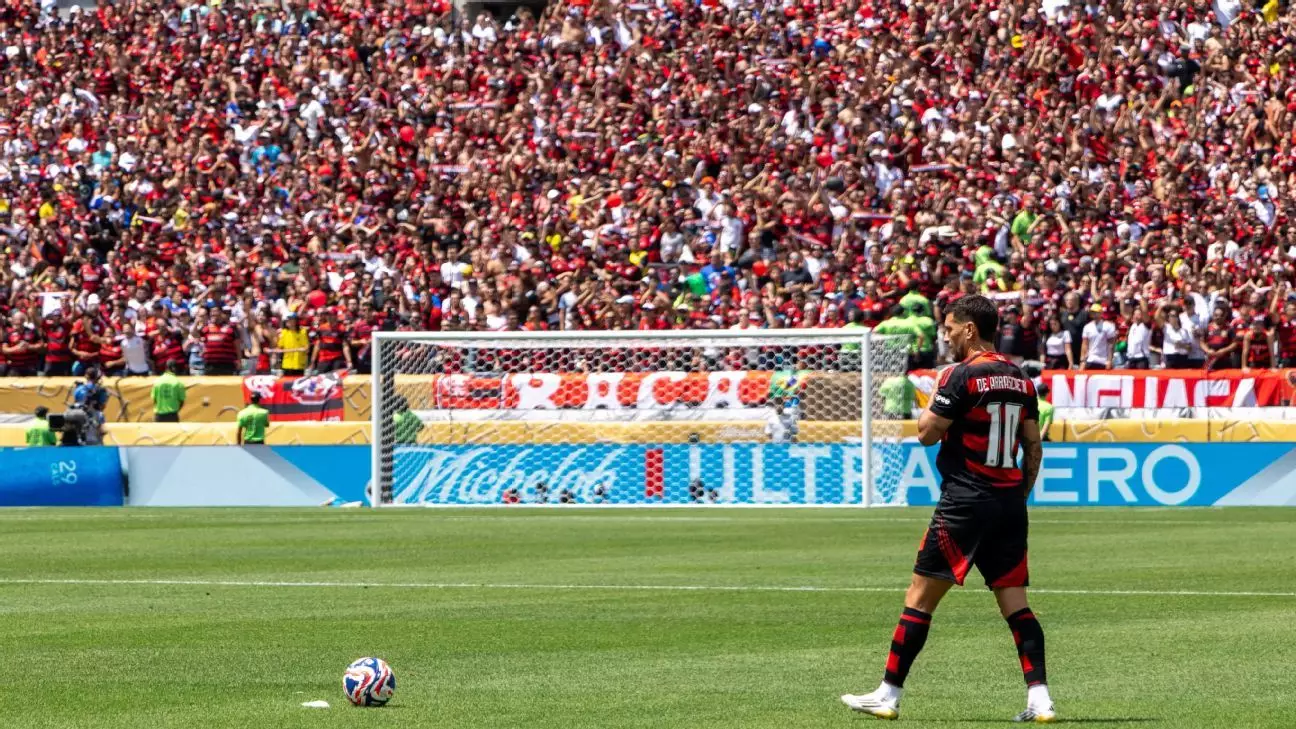Brazil’s ambition to host the next FIFA Club World Cup is not merely a statement of intent; it is a fusion of rich footballing heritage and a passionate fanbase that can breathe life into any competition. As the inaugural 32-team version of this prestigious event unfolds in the United States, Brazil’s enthusiasm stands as a testament to its football culture, embodying an overdue and vibrant resurgence. The current tournament, however, is rife with challenges. Some matches have attracted dismal attendance, and oppressive weather conditions have interrupted gameplay and stifled performance. As captivating as the rousing clashes have been, the true heart of this competition beats strongest in the passionate support emanating from the South American fans.
The enthusiasm from Brazilian and Argentine supporters has brought energy to stadiums, creating an atmosphere that celebrates the beautiful game. In stark contrast to the previously observed apathy toward this competition, these fans challenge skeptics by proving that the stakes are high and the desire to win is palpable. While South American teams find themselves embroiled in fierce competition, the very presence of their supporters lends an irreplaceable life force to the tournament. Their vibrance can often mask the underlying deficiencies of the event, reminding us that football is, at its core, about passion and representation.
The Arrival of the South American Giants
As the tournament inches toward its climax, South American teams are not merely participating; they are asserting their dominance. With the final group matches approaching, Brazilian clubs have surged to the forefront of their divisions, a development that might not have been anticipated by followers of European football. The zeal with which these teams, especially Flamengo and Palmeiras, have approached their games has provided a striking contrast to prior expectations, reestablishing South American football as vibrant and competitive on a global scale.
Historically, South American clubs have faced difficulties competing consistently against their European counterparts. Yet, the current incarnation of the Club World Cup presents a unique opportunity. The format has aligned favorably, allowing teams to play at their peak, mid-season and fully fueled. Each club’s preparation and strategy appear resonant as players, reminiscent of Olympians gearing up for a great challenge, draw upon their talent to captivate audiences and silence critics. Such dynamics forge a compelling narrative of rebirth juxtaposed against historical prejudice.
The Underestimated Strategy of South American Teams
In this tournament, the tactics deployed by South American clubs unveil fascinating layers of competitiveness previously overlooked. The perceived chaos associated with South American football is dispelled by the calculated discipline displayed by teams like Botafogo, which stunned the world by defeating European champions PSG. The match showcased not just defensive acumen but a canny ability to capitalize on momentary lapses of concentration from their opponents. The tireless work ethic, coupled with tactical sophistication, underscores that South American teams are a force to be reckoned with.
Flamengo’s near misfortunes in the Libertadores—with almost facing an early exit—highlight the magnitude of risk-taking inherent in club football. Yet their resilience has become a symbol of South America’s quest for relevance in global football. Meanwhile, Palmeiras’ heavy investment in talent, like acquiring the formidable Vitor Roque, speaks volumes about their aspirations and commitment to excellence. They have managed to blend an intelligent approach to gameplay, proving that success is achievable through rigorous planning and execution.
A Test of Character Amidst High Stakes
As the knockout phase approaches, the questions grow quieter but more profound: can South American teams sustain their success? Factors such as physical endurance in sweltering temperatures and the psychological resilience required to navigate high-stress situations come into play. Botafogo faces a pivotal showdown with Atletico Madrid, where every decision and each moment on the field could be decisive.
While the stakes are high for clubs like Palmeiras and River Plate, who grapple with their own hurdles, one can’t help but marvel at the unyielding spirit exhibited by these teams. River Plate’s coaching philosophy and offensive style reaffirm their commitment to exciting football, even when tactical challenges loom large. This determination, embodied by the robustness of their supporters, propels the narrative of South American clubs as trailblazers unwilling to be sidelined in the face of adversity.
What remains clear through this unfolding drama is that the South American spirit resonates in every facet of the competition. The clubs have not only come to compete but to remind the world that their culture produces warriors who thrive amid the heat of battle. The FIFA Club World Cup is not just an arena of football; it is a stage upon which South America plays for pride, purpose, and the relentless pursuit of glory.


Leave a Reply